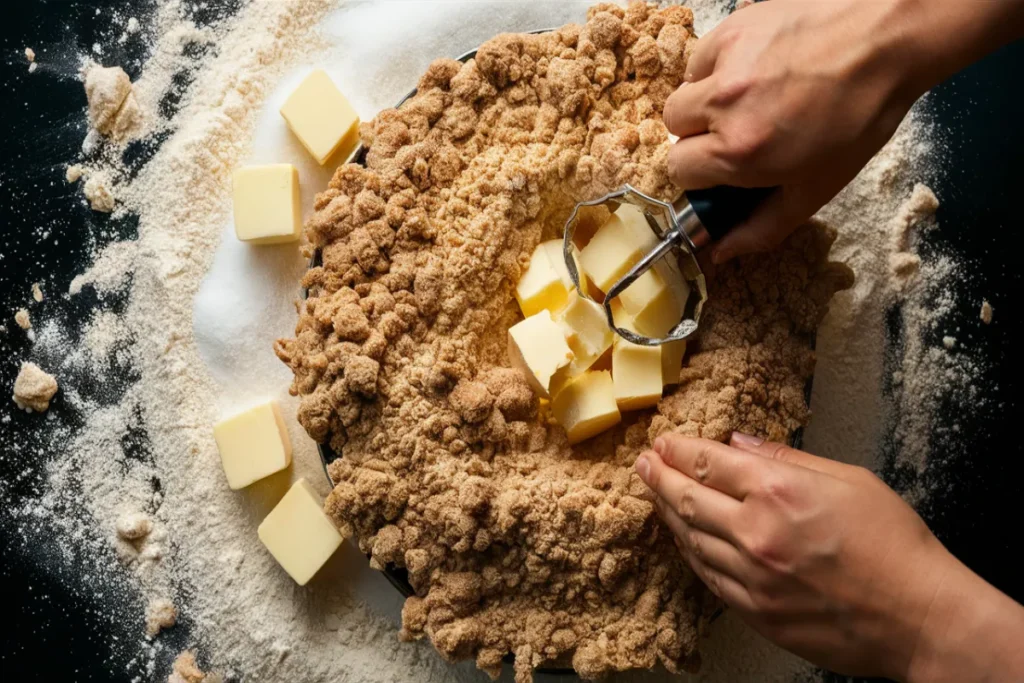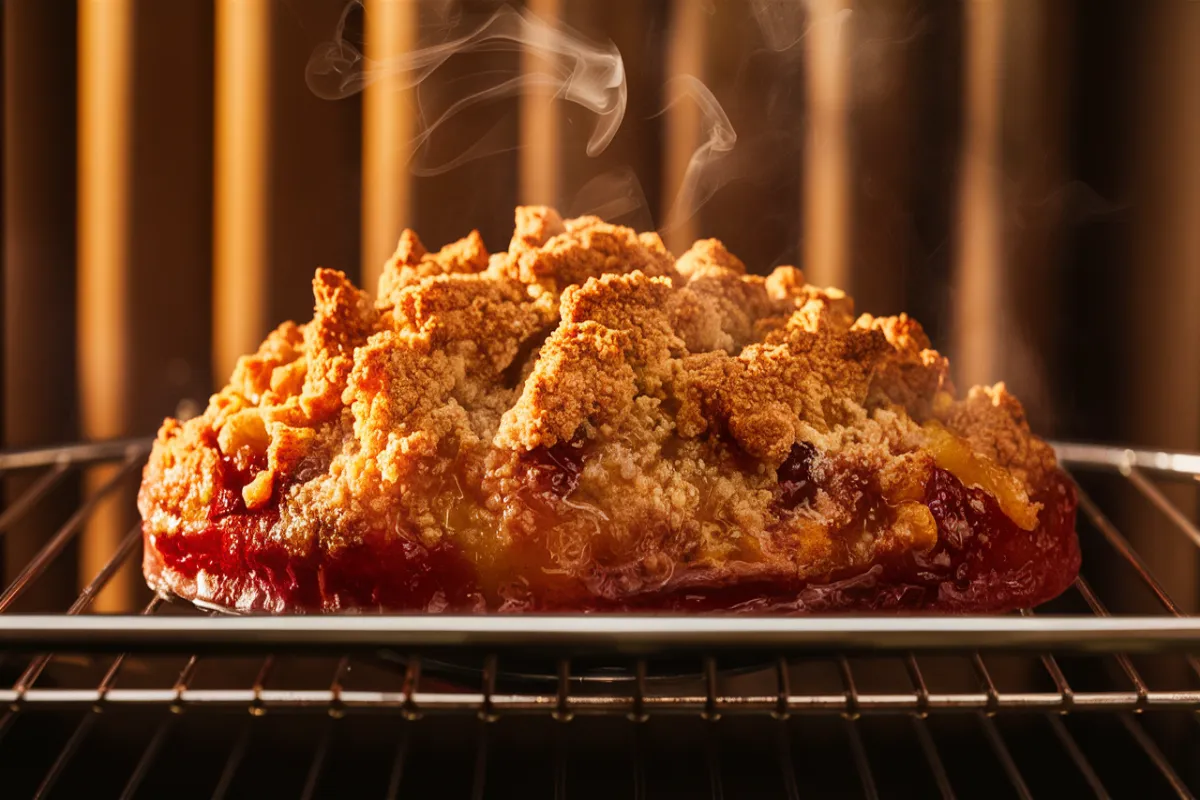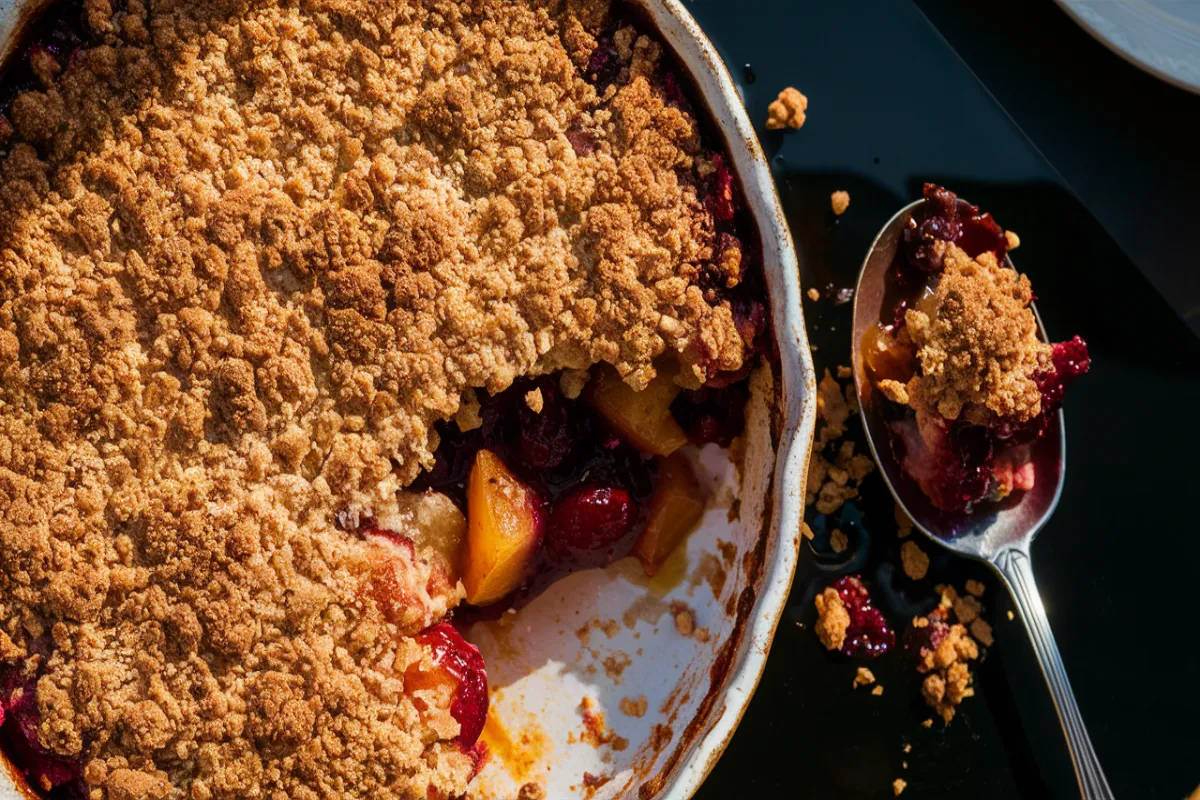A well-made crumble features a golden, crunchy topping that contrasts beautifully with the soft, juicy fruit underneath. Achieving that perfect crunch requires attention to detail and the right techniques. If you’ve ever wondered what the secret to crunchy crumble is, you’re in the right place. This article will walk you through the key elements and methods to ensure that your crumble topping turns out perfectly crisp every time.
1. Understanding the Basics of Crumble
1.1 What Makes a Crumble Crunchy?
The texture of a crumble comes from the combination of flour, sugar, butter, and sometimes oats or nuts. These ingredients create a crumbly topping that, when baked, reveals the secret to crunchy crumble: a golden, crisp finish. The key to achieving the perfect secret to crunchy crumble lies in how you mix and handle these ingredients. Ensuring that the butter is properly incorporated and the topping is evenly spread over the fruit are crucial steps.
1.2 The Role of Ingredients
Each ingredient in the crumble topping plays a specific role in creating that desired crunch. Flour provides structure, while sugar adds sweetness and helps with caramelization. Butter binds the ingredients together and contributes to the richness of the topping. Additional ingredients like oats or nuts can enhance the texture, adding more bite to the crumble.
1.3 The Importance of Proper Technique
Technique is just as important as the ingredients themselves when aiming for that perfect crunchy crumble. How you mix the topping, how you bake it, and how you handle the crumble throughout the process all contribute to the final texture. Properly chilled butter, a well-preheated oven, and careful attention to baking time are all essential elements in achieving the secret to crunchy crumble.
2. Choosing the Right Ingredients
2.1 Flour Selection
The type of flour you use affects the crumble’s texture and is crucial to achieving the secret to crunchy crumble. All-purpose flour works well for a standard crumble topping, providing the right balance of structure and tenderness. If you want a more delicate topping but still aim to uncover the secret to crunchy crumble, consider using cake flour. For a heartier texture, whole wheat flour can add a bit of chewiness, though it may reduce the overall crispness.
2.2 Sugar Types and Their Impact
Sugar plays a vital role in the crunchiness of a crumble. Granulated sugar gives a classic crunch, while brown sugar adds a deeper flavor and slightly softer texture due to its moisture content. If you prefer an extra-crispy topping, try using turbinado or demerara sugar. These sugars have larger crystals that add extra crunch and a subtle caramel flavor.
2.3 Butter: The Key to Crumble
Butter is the cornerstone of a good crumble topping, and it’s essential for achieving that secret to crunchy crumble. Cold, unsalted butter works best because it creates pockets of steam as it melts, leading to a flaky, crisp texture. Always use cold butter and cut it into small cubes before mixing it with the dry ingredients. This technique is key to distributing the butter evenly, which is crucial for that perfect, crunchy crumble topping.
2.4 Adding Oats and Nuts
Oats and nuts can enhance the texture and flavor of a crumble topping. Rolled oats add a chewy texture, while nuts like almonds, pecans, or walnuts provide a satisfying crunch. When adding these ingredients, be sure to mix them in evenly with the flour, sugar, and butter. This even distribution helps the topping bake uniformly, resulting in a consistently crunchy texture.
3. Mixing the Crumble Topping

3.1 The Importance of Cold Ingredients
Cold ingredients are essential for a crunchy crumble. Cold butter, in particular, is crucial because it melts slowly in the oven, allowing the topping to become crisp without turning greasy. Always chill your butter before mixing it with the other ingredients. You can also chill the flour and sugar if you’re preparing the crumble on a hot day to prevent the butter from melting too quickly.
3.2 Mixing by Hand vs. Using a Food Processor
Mixing the crumble topping by hand allows you to control the texture better. Using your fingertips, work the cold butter into the dry ingredients until the mixture resembles coarse crumbs. This method helps create a topping with a rustic, uneven texture that bakes into a crunchy, golden crust. However, if you prefer a finer texture, you can use a food processor. Just be careful not to overmix, as this can lead to a denser topping.
3.3 Achieving the Right Consistency
The consistency of your crumble topping should be crumbly but not too fine. Aim for a mixture that has small clumps of butter-coated flour and sugar. These clumps will melt and crisp up in the oven, creating the crunchy texture you’re looking for. If the mixture is too powdery, add a bit more cold butter and work it in until you achieve the right consistency.
3.4 Adding Texture with Oats and Nuts
To enhance the crunchiness, fold in oats or chopped nuts after the initial mixing. Oats add a chewy texture, while nuts provide a satisfying bite. Be sure to mix them in gently so that they’re evenly distributed throughout the topping. This step ensures that every bite of your crumble has a balanced mix of textures.
4. Preparing the Fruit Filling
4.1 Choosing the Right Fruit
The fruit you choose for your crumble affects the overall texture. Firmer fruits like apples or pears hold their shape well during baking, which helps maintain the contrast between the soft fruit and the crunchy topping. Softer fruits like berries can add juiciness, but they may also make the crumble topping soggier. Consider mixing firmer and softer fruits to balance texture and flavor.
4.2 Preparing the Fruit
Before adding the crumble topping, prepare the fruit by peeling, slicing, and mixing it with sugar, spices, and a thickening agent like flour or cornstarch. This mixture helps the fruit release its juices while thickening them into a syrupy filling. For added flavor, consider adding a splash of lemon juice or a pinch of cinnamon or nutmeg to the fruit.
4.3 Balancing Fruit and Topping
The ratio of fruit to topping plays a crucial role in the final texture of your crumble. Too much fruit can lead to a soggy topping, while too little can make the crumble dry. Aim for a balance where the fruit layer is thick enough to provide juiciness but not so thick that it overwhelms the topping. A 1:1 ratio of fruit to topping usually works well.
4.4 Preventing Sogginess
To prevent the topping from becoming soggy, make sure the fruit filling isn’t too wet. If you’re using juicy fruits like berries, consider tossing them with a bit of flour or cornstarch to absorb some of the excess liquid. Additionally, spreading the fruit in an even layer ensures that the topping bakes uniformly, reducing the chances of sogginess.
5. Assembling and Baking the Crumble
5.1 Layering the Topping
Once your fruit filling is ready, it’s time to layer the crumble topping. Sprinkle the topping evenly over the fruit, ensuring that it covers the fruit completely. Avoid pressing down on the topping, as this can compact it and reduce the crunchiness. Instead, let the topping sit lightly on the fruit, allowing it to bake into a crisp, golden crust.
5.2 Baking at the Right Temperature

Baking temperature plays a significant role in achieving a crunchy crumble. Preheat your oven to 350°F (175°C) for a slow, even bake. This temperature allows the butter to melt gradually, creating a crisp topping without burning. Baking at too high a temperature can cause the topping to brown too quickly, leaving the inside undercooked.
5.3 Checking for Doneness
To check if your crumble is done, look for a golden-brown topping and bubbling fruit around the edges. The topping should feel firm and crunchy when lightly pressed. If the topping is golden but the fruit isn’t bubbling, cover the dish with foil and bake for an additional 5-10 minutes. This method ensures that the fruit is fully cooked without over-browning the topping.
5.4 Resting Before Serving
After baking, let the crumble rest for 10-15 minutes before serving. This resting period allows the topping to firm up and the fruit filling to thicken. Serving the crumble too soon can cause the topping to lose its crunch as it absorbs the fruit juices. However, avoid letting the crumble sit for too long, as the topping can become soggy.
6. Enhancing the Crunchiness
6.1 Adding a Sugar Sprinkle
For an extra layer of crunch, consider sprinkling a little granulated or turbinado sugar over the crumble topping before baking. This sugar will caramelize in the oven, adding a sweet, crispy finish to the topping. Be careful not to add too much, as this can make the topping overly sweet.
6.2 Incorporating Spices
Adding spices to your crumble topping can enhance the flavor without sacrificing crunch. Cinnamon, nutmeg, or ginger can add warmth and depth to the topping. However, avoid adding too much spice, as it can overpower the other flavors. A light sprinkling of your chosen spice mixed into the topping works best.
6.3 Experimenting with Flours
Different flours can alter the texture of your crumble topping. For a more delicate crunch, try using a blend of all-purpose flour and almond flour. Almond flour adds a nutty flavor and a finer texture, enhancing the overall crunchiness. You can also experiment with whole wheat flour for a heartier texture, though it may result in a slightly denser topping.
6.4 Using Flavored Butters
Flavored butters can add a unique twist to your crumble topping. For example, use browned butter to add a nutty, caramel-like flavor to the topping. Simply melt the butter in a pan until it turns golden brown, then let it cool before mixing it into the dry ingredients. The rich flavor of browned butter enhances the crunchiness and adds depth to the crumble.
7. Avoiding Common Mistakes
7.1 Overmixing the Topping
One common mistake is overmixing the crumble topping. Overmixing can cause the butter to melt into the flour, resulting in a dense, greasy topping. To avoid this, mix the ingredients just until they form coarse crumbs. This method ensures that the topping remains light and crumbly, baking into a crisp, golden layer.
7.2 Using Soft Butter
Using soft or melted butter can lead to a soggy topping. Always use cold butter straight from the refrigerator to create the right texture. If your butter starts to soften while you’re working, pop it back in the fridge for a few minutes to firm it up. Cold butter ensures that the topping remains light and crisp during baking.
7.3 Baking at Too High a Temperature
Baking your crumble at too high a temperature can cause the topping to brown too quickly while the inside remains undercooked. Stick to a moderate temperature of 350°F (175°C) for even baking. If your crumble is browning too quickly, cover it with foil for the remainder of the baking time. This method prevents burning while ensuring the topping becomes perfectly crunchy.
7.4 Not Allowing the Crumble to Rest
Another mistake is serving the crumble too soon after baking. Letting the crumble rest for 10-15 minutes allows the topping to firm up and the fruit filling to settle. This short resting period helps maintain the topping’s crunchiness and prevents it from becoming soggy from the hot fruit juices.
8. Customizing Your Crumble
8.1 Adding Different Nuts and Seeds
Nuts and seeds can add variety and texture to your crumble topping. Try adding chopped hazelnuts, pistachios, or sunflower seeds for a unique twist. These ingredients add extra crunch and flavor, making your crumble topping even more satisfying. Just be sure to chop the nuts finely so they blend well with the other ingredients.
8.2 Using Different Sugars
Experimenting with different types of sugar can change the flavor and texture of your crumble topping. Brown sugar adds a caramel-like richness, while turbinado sugar adds extra crunch. You can also mix sugars for a more complex flavor profile. Just remember that different sugars may affect the overall sweetness, so adjust the amount according to your taste.
8.3 Incorporating Dried Fruits
Dried fruits can add a chewy texture and bursts of sweetness to your crumble. Consider adding chopped dried apricots, cranberries, or raisins to the topping. These fruits pair well with the crispy topping and the soft, baked fruit filling. However, avoid adding too much, as the topping may become too dense.
8.4 Trying Different Flavor Combinations
Don’t be afraid to get creative with your crumble flavor combinations. For example, add a touch of vanilla extract or almond extract to the topping for added depth. You can also experiment with different spices or even add a splash of liquor to the fruit filling for an extra kick. The key is to balance the flavors without overpowering the crunchiness of the topping.
9. Frequently Asked Questions
9.1 How Do I Keep My Crumble Topping Crunchy?
To keep your crumble topping crunchy, use cold butter, avoid overmixing, and bake at a moderate temperature. Also, let the crumble rest before serving.
9.2 Can I Make Crumble Topping Ahead of Time?
Yes, you can make crumble topping ahead of time. Store it in the refrigerator until ready to use. This step ensures the butter remains cold, which is key for achieving a crunchy texture.
9.3 What Should I Do If My Crumble Topping Is Too Soft?
If your crumble topping is too soft, try increasing the baking time slightly or use a different type of sugar, such as turbinado, for extra crunch. Also, ensure your butter is cold when mixing the topping.
9.4 Can I Freeze Crumble Topping?
Yes, crumble topping can be frozen. Store it in an airtight container or freezer bag for up to three months. When ready to use, bake directly from frozen.
9.5 What Are Some Good Fruit Combinations for Crumble?
Apples and berries, peaches and raspberries, or pears and cranberries make great combinations. These fruits provide a balance of sweetness and tartness, complementing the crunchy topping.
Conclusion
Achieving the perfect secret to crunchy crumble requires the right combination of ingredients, technique, and baking. By choosing the right flour, sugar, and butter, and following the tips outlined in this article, you can master the secret to crunchy crumble, creating a topping that is golden, crisp, and full of flavor. Remember to keep your butter cold, avoid overmixing, and bake at the right temperature for the best results. Whether you’re making a traditional apple crumble or experimenting with new flavors, these tips will help you create a dessert that is both satisfying and delicious.

